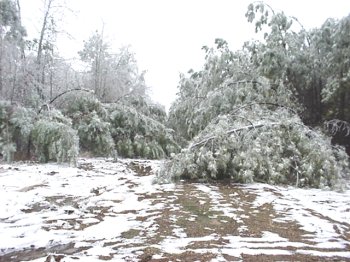
Bayou State Weather, LLC - Providing detailed weather information for Louisiana and surrounding areas
U.S. Time Zones and UTC Time
|

. . .Coming To A Town Near You!
As we approach the Christmas holiday season, it's time to prepare for winter weather events here in the deep south. While we usually do not experience the blizzard conditions our northern friends endure, we do have our share of winter weather problems with the occasional snow or ice event. While snow and/or icing is usually only an inconvenience for locations equipped to handle it, southern states have little means to fight winter weather. We usually just have to sit it out and wait for it to melt!
 Snowfall events, while somewhat rare, are usually a welcome sight to our area. They usually give the kids and kids at heart an "extra" day off to play in the snow. Snow does little or no damage to man-made structures and trees, and usually melts away in a day or two. Ice storms, i.e. freezing rain, sleet, and snow, do cause more than just a little inconvenience. Damage to structures and trees can be significant and costly.
Snowfall events, while somewhat rare, are usually a welcome sight to our area. They usually give the kids and kids at heart an "extra" day off to play in the snow. Snow does little or no damage to man-made structures and trees, and usually melts away in a day or two. Ice storms, i.e. freezing rain, sleet, and snow, do cause more than just a little inconvenience. Damage to structures and trees can be significant and costly.
North Louisiana has experienced quite damaging ice storms during the past two consecutive years, one of which occurred during Christmas of 1998. Ice, with its destructive weight, causes considerable damage to trees, power lines, and man-made structures. It also creates very dangerous driving conditions which result in accidents and injury. Typically ice storms last two to three days but its affects can be long lasting. Electrical power is usually affected the most during an ice event, sometimes taking as much as two weeks or longer for restoration.
Typical aspects of winter weather include: extreme cold, snow, sleet, and freezing rain. In the south, we usually do not have much of a problem with extreme cold. However, Arctic outbreaks do sometimes invade the area dropping temperatures into the teens or single digits with wind chill factors some 10 to 20 degrees below zero. Should we experience conditions of that nature, it is important to prepare beforehand and take necessary precautions.
Winter Storm Watch
Issued when winter storm conditions - heavy snow, freezing rain, or sleet - are possible within the next 12-36 hours.
Winter Storm Warning
Issued when winter storm conditions are likely to occur within the next 12-24 hours or are occurring.
| 1. Dress in layered clothing, not one large heavy piece of clothing.
2. Protect extremities, such as face, ears, hands, and feet with masks, gloves, and adequate footwear. 3. Keep the head covered with a warm cap or hat. A large amount of the body's heat escapes through the head. |
Ice Events
| 1. Plan ahead. Assume you will be without utilities (power, water, gas, communications) for an extended period of time - perhaps several weeks.
2. Stock up on emergency supplies if a winter storm watch is issued - canned foods, nonperishable foods, manual can opener, water, flashlights, candles, matches, batteries, first aid kit, blankets, battery radio, and a source of heat such as a kerosene heater or fireplace. 3. If you must travel, take along a winter survival kit in your vehicle just in case. The survival kit should include items as: a flashlight, blanket, matches and candles, tin can, first aid kit, sand, booster cables, tow chain, and emergency food such as candy, nuts, etc. 4. Adhere to the advice and warnings of local law enforcement agencies and National Weather Service offices. If they say, "Don't go out," DON'T! 5. Stay away from any fallen electrical power lines or touch objects that have fallen onto lines. |